Test of Honour –The Best $50 Game You are Not Playing!
by Tom Burgess
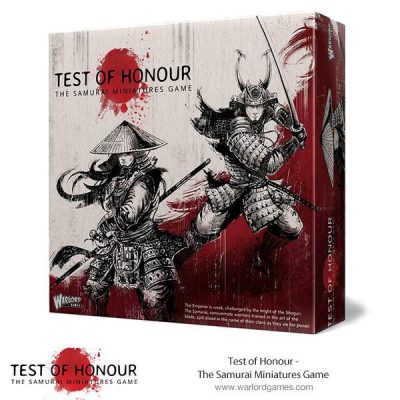 has become one of my favorite games over this past year. I was immediately drawn to it as I’ve always been a big fan of Akira Kurosawa’s Samurai movies, but a year’s worth of gameplay with it has greatly heightened my appreciation for Test of Honour as a fast and exciting skirmish game.
has become one of my favorite games over this past year. I was immediately drawn to it as I’ve always been a big fan of Akira Kurosawa’s Samurai movies, but a year’s worth of gameplay with it has greatly heightened my appreciation for Test of Honour as a fast and exciting skirmish game.
This is especially impressive as skirmish games as a wargame genre are not normally my forte. This made me wonder why I was not seeing more of Test of Honour being played if it was a game system that could get a non-skirmish guy like me so enthralled with it.
My guess is that many people just have not really taken a good look at it or maybe have not managed to get in a demo game. My hope is that this article encourages some players to consider trying the game and hopefully to seek out a demo game. So where to start…..?
Did I mention that the base game is only $50 US? The game is designed to be played with five to 20 models, and guess what? You get five Samurai (Heroes) and 40 Ashigaru (Common Troops) in the box set. Most “starter” box game systems only give you small starting forces requiring later “booster” purchases to get up to full armies.
But Test of Honour’s starter set provides enough models for two FULL armies. Though there are plenty of expansion sets, what comes in the starter set is more than enough to cover requirements for two full forces. The starter set also comes with enough 2D terrain to play the six battles presented in the Battle Guide. Dice and required cards are needed are also included. Just the starter set alone is going to provide you all that you need for game after game of excitement.
The next thing that I really appreciate about the game is the simplicity. The main rules are just 16 pages long. The successes of attempted actions are determined by rolling a number of special dice.
These six-sided dice have two blank sides, two sides with one “Sword” symbol, one side with two “Sword” symbols and one side with the dreaded “X” symbol.
The number of dice rolled when determining the success of an action are based on the skill of the warrior attempting the action. A commoner or ashigaru typically roles three dice, a minor hero/samurai rolls four dice, and a samurai lord/major hero roll five dice.
The typical actions warriors take tests for are “Strike” (i.e. hit an enemy warrior), “Avoid” (i.e dodge an enemy’s attack) and “Damage” (i.e. Dice can be added to or subtracted from the pool used for the tests based on circumstances. For example, an ashigaru archer shooting at an enemy behind a wall will have to drop a die from his attack roll, going from three dice down to two dice. Another example would be when doing a test for damage on an enemy, previous minor wounds, marked by “Blood Drops” each add a die to damage dice pool helping to ensure that the enemy is put down for good this time.
The way the symbols on the dice work is as follows. No matter how many dice are rolled you will achieve one of the following results;
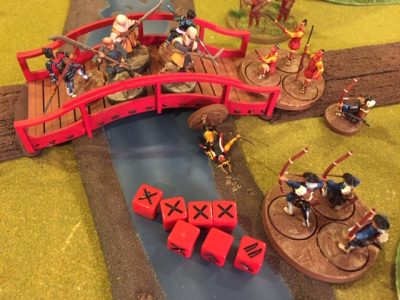
Success – requires three or four “Sword” symbols to come up from the dice (and more “Swords” than “X”s”)
Spectacular Success – achieved when five or more “Sword” symbols. These often grant extra benefits like knocking an opponent to the ground in a test to hit, a counter-thrust attack in a test to avoid, or a follow-on extra attack in a test to damage.
Fumble – occurs when you have more “X’s” than “Swords” on the dice faces. These could result in lost footing or minor damage “Blood Drops” to self.
The activation of warriors in Test f Honour is similar to other “chit pull” of “dice pull systems.” Commoners will have up to one action a turn and one commoner counter for each will go in the “cup” for each turn. Heroes can activate two or three times per turn. Two hero counters will go into the “cup” for each minor hero and three for each lord every turn. In addition, three are three “Fate” counters that also go into the counter “cup” for each turn.
During the turn, each player alternates pulling a counter from the “cup” and activating a warrior. Commoner counters allow an activation of a commoner and hero counters allow activation of heroes. If you draw a counter type you and no longer have any warriors of that type left to activate, you pass that counter to your opponent to activate his appropriate warrior type and then your opponent still gets the next draw. You continue doing his until one of two things happens, all warriors on both sides have activated or the third “Fate” counter has been drawn from the cup ending the turn.
 When you draw a “Fate” counter you effectively pass the initiative to your opponent. This adds a level of randomness to what otherwise would be an I-Go-U-Go game. You may think you’re going next, but “Fate” may dictate otherwise. The drawing third “Fate” counter will prematurely end the turn, keeping you from completing your plans before your opponent has a chance to activate first next turn and avoid your trap.
When you draw a “Fate” counter you effectively pass the initiative to your opponent. This adds a level of randomness to what otherwise would be an I-Go-U-Go game. You may think you’re going next, but “Fate” may dictate otherwise. The drawing third “Fate” counter will prematurely end the turn, keeping you from completing your plans before your opponent has a chance to activate first next turn and avoid your trap.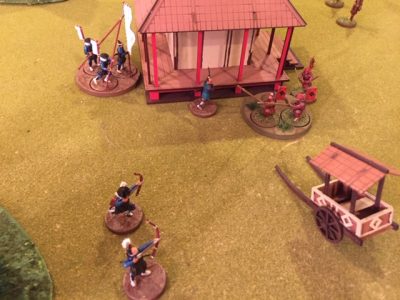
Activation counters are also drawn also when a warrior is required to make an Avoid Test. When one of your warriors is hit by an enemy attack and still has available actions left for that turn, you must reach into the counter “cup” and pull out one appropriate counter for that warrior to use to try to evade. This allows the warrior to roll for an Avoid. If successful, the warrior sidesteps the attack, but this will have been one of the warrior’s activation (only activation for a commoner) that turn.
 If the warrior fails the Avoid test or cannot be assigned another action because he’s already used all of his activation counters for that turn, then the hit lands on its target and you move to determine damage.
If the warrior fails the Avoid test or cannot be assigned another action because he’s already used all of his activation counters for that turn, then the hit lands on its target and you move to determine damage.
Damage is done by a test of Strength. If successful that hit “kills” the targeted warrior and he is removed from the game if the test fails the targeted warrior is wounded and is given a “Blood Drop.” Blood drops add one dice to each future “Damage” test against the target warrior and the remove one dice for each from “Honour” test (basically an individual morale test).
Samurai heroes, when receiving a successful Damage roll, are not automatically knocked out of the game like normal commoner warriors. They may take a “Test of Honour,” removing one dice from the test dice pool for each “Blood Drop” accumulated. If they pass, they show they have the resolve to fight on wounded. Instead of being taken out of the game, they are dealt a random injury card which will assign them further negative effects depending on the specific injury. Note, though an injured samurai may be able to avoid being knocked out of the battle, each samurai can only sustain one injury and keep fighting. The next one will knock them out of the game whether they pass a Test of Honour or not.
What are those large bases with three warriors on them for? Those are commoner groups. These groups only get one activation per turn like a single commoner warrior. While they have two or three warriors on the base, they have of their stats enhanced. When they take a loss, they lose just one of the warriors and continue to operate. They are kind of a bargain as you normally get three warriors of the given type for the price of two single warriors with some boosted stats and some grater resiliency, but the drawback is the single activation each turn for the whole group whereas three single warriors could each take an activation.
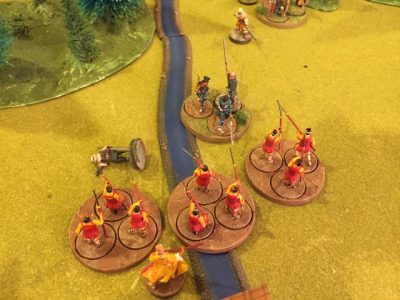
The key to this game, especially when dealing with samurai heroes, is to mass your attacks. You want as many commoners as you can causing the enemy’s samurai heroes to react and burn up their activations on defense so that your own samurai heroes can close in and dispatch the “exhausted” enemy more easily. That’s always the plan, but then those “Fate” counters come into play allowing an enemy commoner to step in front of his exhausted lord to shield him from the enemy for the rest of the turn. Or the third “Fate” counter for the turn is drawn causing the turn to end early allowing all warriors to refresh their activation potential.
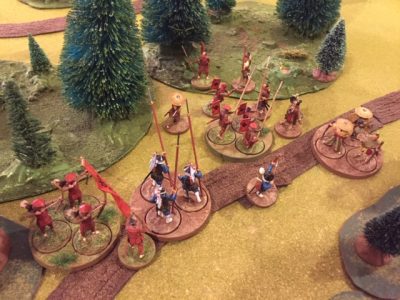 I have laid out the basics of the game here. There are other rules like moving cautiously, reloading muskets, mounted warriors, “Tests of Wits” to see if you can identify an opponent in the dark, “Test of Honour” to see if warriors stay in the fight, and more. What I have done here is focus on the close combat aspects of the game system which to me is the heart and soul of the game.
I have laid out the basics of the game here. There are other rules like moving cautiously, reloading muskets, mounted warriors, “Tests of Wits” to see if you can identify an opponent in the dark, “Test of Honour” to see if warriors stay in the fight, and more. What I have done here is focus on the close combat aspects of the game system which to me is the heart and soul of the game.
Games are usually played with up to 24 points of troops. A samurai lord might come in at five to eight points depending on extra skills and equipment. A minor samurai hero starts off at four points. A Single Warrior is one point or two points with a bow. A warrior group is usually two points (for three warriors) and three points when bow armed. Turns are fast and some scenarios only last five turns. In most cases games last about 30 to 40 minutes, rarely exceeding one hour. I’ll typically run four or five demos a day at my local game store, Hard Knox Games when I host games there.
If you like classic Samurai movies and you are a wargamer, you really do owe it to your self try this game out! At $50 for the starter set, you can easily do both sides for any game which alleviates the need to get someone else to go in on the game system with you. One player can easily provide everything needed to host game after game.
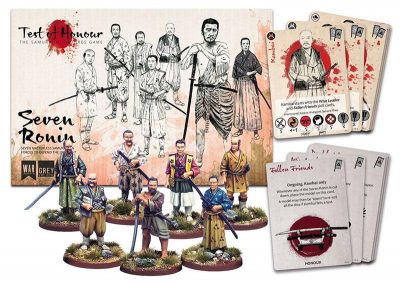
If you end up really liking the game, there are expansions sets that add special heroes, warrior monks, mounted warriors, bandit, ninjas, and even the women warrior Onna-Bugiesha. And they just added the “Seven Ronin” boxed set which is its own one box army.
What if you don’t like Samurai movies? The game’s creators are releasing a Classical Greek period version of the rules in early 2019 called “Mortal Gods.” It will have Spartans, Persians, and even a bit of mythology if you want it! The system is so easy that I think it could be ported over to just about any period skirmishing. I myself am thinking about adapting it to Dark Age battles. I know I will have years and years of great fun out of this game system making it one of my best all-time wargame purchases. I bet if you try it, you’ll feel the same way! The game is cheap, fast, easy, and most of all a ton of FUN!

> What if you don’t like Samurai movies?
How could you not? 😛
This looks like just the game for me. I like streamlined skirmish games, and of course I love the setting. Still waiting for my copy to arrive…
Great! Let us know how you like the game when you get to playing it!
“> What if you don’t like Samurai movies? How could you not? ” I just watched “The Samurai Trilogy” over the holidays.
Love the game, hate the fiddly plastic multi-part figures. Think I’ll replace them all with metal figures.
Yes the repurposed old Wargames Factory models are not the easiest figures to assemble. But they are what makes this starter set with two FULL armies so cheap. The key here is that it allows a low initial investment to try the game out. That all being said, I actually do like the plastic mounted Samurai. These came out later than the foot figures and seem to have incorporated some changes that made them easier for me to work on.
To add to this. The game is going to be getting a 2nd edition (Just announced) with full backwards compatibility to the boxed set.
I agree with the fiddly plastic figures… so I just use the multitude of metal ones you can find all over the internet.
One nice thing of this system is that you are not compelled to use ‘their’ figures… it all works.